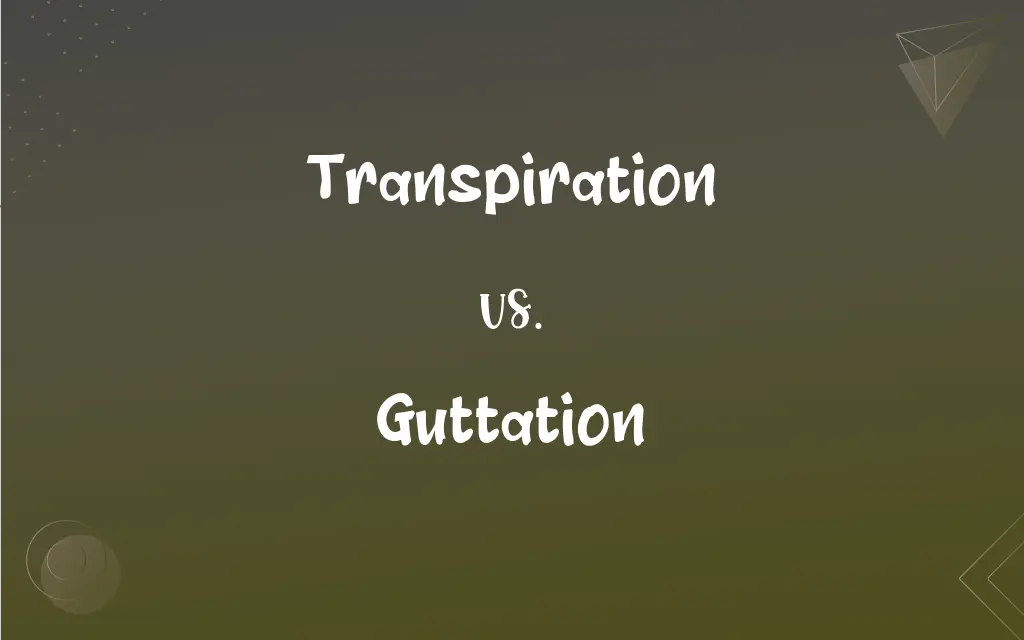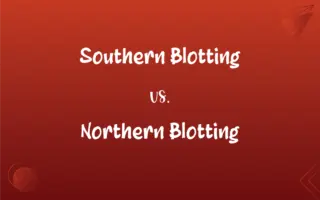Transpiration vs. Guttation: What's the Difference?
Edited by Aimie Carlson || By Harlon Moss || Updated on October 21, 2023
Transpiration is the evaporation of water from plant surfaces, primarily leaves, while guttation is the exudation of water droplets from leaf edges or tips due to root pressure.

Key Differences
Transpiration is a fundamental process in plants where water vapor is released into the atmosphere through tiny openings called stomata. In contrast, guttation occurs when water, under certain conditions, oozes out as droplets from the edges or tips of leaves.
The primary driving force for transpiration is the sun, causing water to evaporate from leaf surfaces. Guttation is driven by root pressure, especially when soil moisture is high, and transpiration is low.
Through transpiration, plants regulate temperature, exchange gases, and distribute nutrients. On the other hand, guttation is a byproduct of the plant's inability to transpire efficiently, often seen early in the morning.
Transpiration typically occurs from specialized structures like stomata and involves a vast amount of water loss. In contrast, guttation emerges from hydathodes, specialized structures for this purpose, and represents a minimal water loss.
While transpiration plays a significant role in the global water cycle, guttation has a more localized effect, mostly visible in specific conditions in certain plants.
ADVERTISEMENT
Comparison Chart
Mechanism
Evaporation from plant surfaces.
Exudation from leaf tips or edges.
Driving Force
Sun and atmospheric conditions.
Root pressure.
Structures Involved
Stomata.
Hydathodes.
Volume of Water
Significant.
Minimal.
Time of Occurrence
Primarily during the day.
Often seen early morning or night.
ADVERTISEMENT
Transpiration and Guttation Definitions
Transpiration
The plant's method of water vapor release into the atmosphere.
Transpiration plays a role in the water cycle.
Guttation
Exudation of liquid water from leaf tips or edges.
Guttation can be a sign of abundant soil moisture.
Transpiration
Water vapor loss from plant parts, mainly leaves.
High temperatures can increase the rate of transpiration.
Guttation
The release of water droplets from plant leaves.
I observed guttation on the strawberry plant this morning.
Transpiration
The process of water movement through plants and its evaporation.
Transpiration helps plants cool down on hot days.
Guttation
The process where plants ooze out water due to root pressure.
Guttation droplets were visible at the edge of the leaf.
Transpiration
The evaporation of water from plant aerial surfaces.
Through transpiration, plants release water back to the environment.
Guttation
The result of the inability of plants to transpire efficiently.
After a heavy rain, guttation is commonly seen on some plants.
Transpiration
The plant's way of excreting excess water.
Cactus plants have adapted to reduce transpiration and conserve water.
Guttation
The manifestation of water droplets on plant surfaces.
Guttation is different from dew as it comes from within the plant.
Transpiration
The act or process of transpiring, especially through the stomata of plant tissue or the pores of the skin.
Guttation
The exudation of water from leaves as a result of root pressure.
Transpiration
(botany) The loss of water by evaporation in terrestrial plants, especially through the stomata; accompanied by a corresponding uptake from the roots.
Guttation
(botany) The exudation of drops of water from the leaves of some vascular plants as a result of root pressure.
FAQs
What drives transpiration?
Transpiration is driven by sun and atmospheric conditions.
When is guttation most visible?
Guttation is often most visible early in the morning or at night.
What is guttation?
Guttation is the exudation of water droplets from leaf edges or tips due to root pressure.
When does transpiration primarily occur?
Transpiration primarily occurs during the day when the sun is out.
What causes guttation in plants?
Guttation is caused by root pressure, especially when soil moisture is high.
Does transpiration use a significant amount of a plant's water?
Yes, a large portion of a plant's absorbed water is lost through transpiration.
Is transpiration beneficial for plants?
Yes, transpiration helps in nutrient uptake, temperature regulation, and gas exchange.
Is guttation the same as dew?
No, guttation originates from within the plant, while dew is from atmospheric moisture.
What role does wind play in transpiration?
Wind can increase transpiration rates by removing water vapor from leaf surfaces faster.
Can guttation droplets contain more than just water?
Yes, guttation droplets can sometimes contain dissolved nutrients and minerals from the plant.
Can guttation indicate soil moisture levels?
Yes, guttation often indicates high soil moisture levels.
How does transpiration impact the environment?
Transpiration plays a significant role in the water cycle and can affect local humidity.
Do all plants exhibit guttation?
No, guttation is more common in certain plants and under specific conditions.
Is guttation harmful to plants?
Guttation in itself is not harmful but can indicate overwatering or other conditions.
Are there plants that never show guttation?
Yes, many desert plants and those with deep roots rarely show guttation.
What is transpiration?
Transpiration is the evaporation of water from plant surfaces, mainly leaves.
Which structure facilitates transpiration?
The stomata, tiny openings on leaves, facilitate transpiration.
From where does guttation occur in plants?
Guttation occurs from hydathodes located on leaf edges or tips.
Can transpiration rates vary?
Yes, transpiration rates can vary based on environmental conditions and plant species.
How can one reduce transpiration in plants?
Reducing light intensity or increasing humidity can reduce transpiration rates.
About Author
Written by
Harlon MossHarlon is a seasoned quality moderator and accomplished content writer for Difference Wiki. An alumnus of the prestigious University of California, he earned his degree in Computer Science. Leveraging his academic background, Harlon brings a meticulous and informed perspective to his work, ensuring content accuracy and excellence.
Edited by
Aimie CarlsonAimie Carlson, holding a master's degree in English literature, is a fervent English language enthusiast. She lends her writing talents to Difference Wiki, a prominent website that specializes in comparisons, offering readers insightful analyses that both captivate and inform.































































